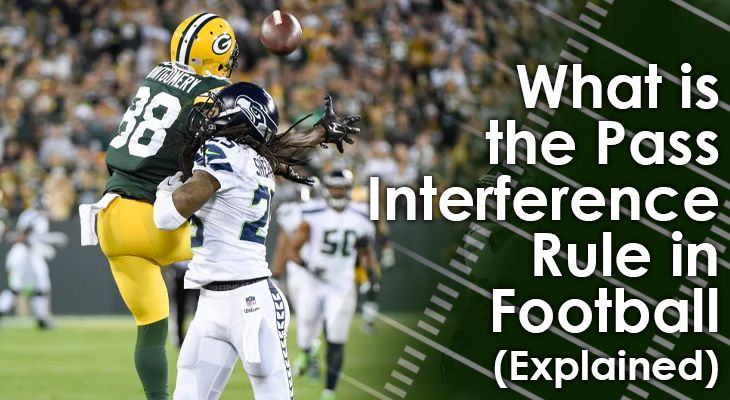The pass interference rule in football is one that's often surrounded by controversy.
It seems that on just about every incomplete pass attempt, a receiver tries to get a ref to call pass interference while the defender says no. Turn on any NFL game, and you're bound to see that situation unfold multiple times a game.
Pass interference penalties are being called more now than they have been in the past.
This is because the NFL and other leagues have made it a point to crack down on contact between receivers and defenders.
But, what is the pass interference rule in football, and how does it apply to receivers and defenders?
Let's take a look at this rule, which is very important for all players to understand from a young age.
What is Defensive Pass Interference?
Defensive pass interference is the most common 'P.I.' penalty called.
According to the rule book, a referee must call pass interference when a defender interferes or hinders a receiver's fair attempt at catching a football.
Here, the contact must occur at least one yard beyond the line of scrimmage.
Some examples of illegal plays include:
- A defender shoving or pushing the opponent
- Hooking a player so they aren't able to move like they normally would
- Cutting off the receivers's path to the football without making a play on the football
- Contacting another player that interferes with his ability to catch a pass
There are slight variations to this rule, though, depending on the level of football we're talking about.
NFL Defensive Pass Interference
In the NFL, defensive pass interference is called if...
- an infraction happens at least one yard past the line of scrimmage,
- while a pass attempt is actually in the air,
- and the ball hasn't yet touched a receiver or defender.
This, however, can only happen on plays where a forward pass occurs.
Which means there can't be pass interference penalties on screen passes that happen behind the line of scrimmage.
In the NFL, when referees call a defensive pass interference, it's what's known as a "spot foul." The ball will be moved to the exact spot on the field where the infraction was done, and the offense will also be awarded an automatic first down.
If the defensive pass interference occurs in the end zone, the ball will be placed at the one yard line, and the offense will get a first down at that spot.
College Defensive Pass Interference
In college football, the basic rule of defensive pass interference is about the same as it is in the NFL.
What differs is what happens on penalties of this kind .
If the penalty happens more than 15 yards beyond the line of scrimmage, the offense gets awarded 15 yards and an automatic first down.
If the penalty happens within 15 yards, it's a spot foul and works exactly like the NFL rule does.
If it occurs between the two yard line and the 17 yard line, the offense will get the ball at the two yard line, along with an automatic first down.
Inside the two yard line, the offense will get the ball at the halfway point between the last previous spot of the ball and the goal line, along with the automatic first down.
Youth Defensive Pass Interference
Just about every youth football league -- from the very beginning to high school football -- follows the defensive pass interference rules of the NCAA (collegiate level).
Again, what constitutes a defensive pass interference penalty is exactly the same in youth football as it is in the NFL and NCAA football.
Offensive Pass Interference
Pass interference can also be called against the offense.
This follows the same basic principle of defensive pass interference.
If an offensive player impedes a defensive player's ability to get to an attempted pass, then the referee should call offensive pass interference.
This is because once the quarterback puts the ball in the air, every player on the field is technically an eligible receiver.
In other words, defensive players have an equal right to try to catch the football as offensive players do.
Therefore, if a receiver impedes a cornerback's ability to intercept a pass, then he has committed an offensive pass interference penalty.
What happens after an offensive pass interference is different from a defensive penalty, though.
In the NFL, an offensive PI penalty results in a 10-yard penalty on the offense, and a repeat of the previous down.
In all other levels of the game, it's a 15-yard penalty on the offense and a repeat of the down.
It's still a tough penalty for the offense to take, especially outside of the NFL, but it's not nearly as bad as the defensive PI result could be.
Conclusion
The pass interference penalty in football is one that fans, players, and coaches argue about in games every week. And it happens often throughout the game.
Receivers always want a pass interference penalty called on the defense, and the defense always thinks it avoided such a penalty.
Youth coaches need to teach their players what the pass interference rule is -- for both defense and offense -- so they understand what they are and aren't allowed to do on pass attempts.
By teaching players the proper rules, you can teach them good techniques to avoid a pass interference penalty.

